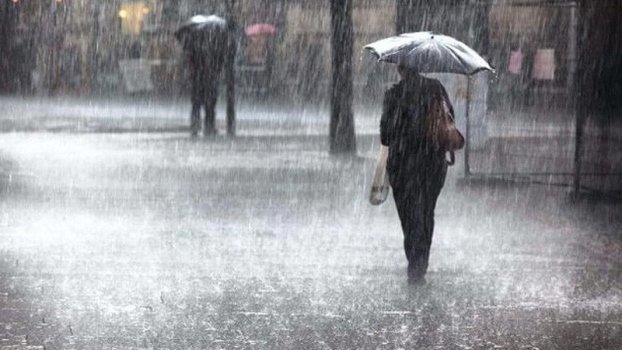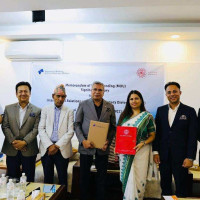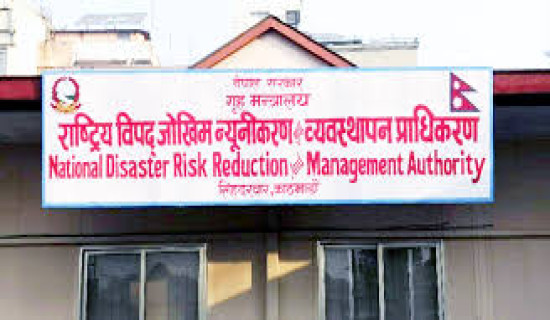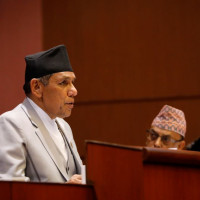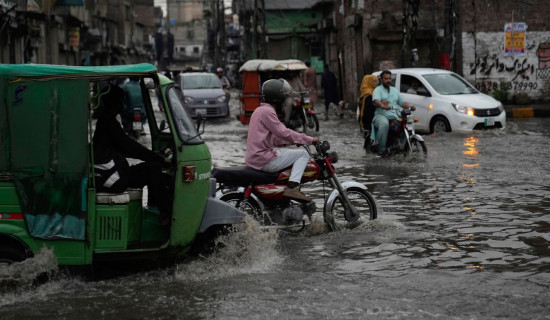- Tuesday, 1 July 2025
Brace for more precipitation, higher temperature this monsoon
By A Staff Reporter,Kathmandu, May 22: The Department of Hydrology and Meteorology has forecast that both rainfall and temperature will be above average during this year's monsoon season.
Releasing its seasonal monsoon outlook on Wednesday, the DHM said that both temperature and rainfall are expected to exceed the average this monsoon, which could lead to increased impacts on natural disasters and human health.
Presenting the seasonal monsoon outlook for 2025, Bibhuti Pokharel, Chief of the Climate Section under the Department of Hydrology and Meteorology (DHM), said that there is a likelihood of above-average rainfall in most parts of the country during the four-month monsoon season from June 1 to September 30.
He also stated that both maximum and minimum temperatures are expected to be above average across the country. Rainfall is projected to be 35 to 65 per cent above average, depending on the location.
The probability of above-normal rainfall in the eastern part of Karnali Province, the northern part of Lumbini, and most parts of Gandaki Province -- between 55 and 65 per cent.
Similarly, the southern part of Sudurpaschim, the western part of Lumbini, and the northern parts of Bagmati and Koshi Province are expected to have a 45 to 55 per cent chance of above-average rainfall.
In Madhes Province, the eastern and southern regions are likely to receive near-average rainfall, with a 35 to 45 per cent chance of above-average precipitation.
The remaining areas of the country also show a 35 to 45 per cent probability of above-average rainfall, Pokharel said.
At the same time, the maximum and minimum temperatures across the country are also likely to be above average. The probability of above-average maximum temperatures is between 55 per cent to 65 per cent in the northwestern part of Sudurpaschim Province, northern part of Karnali Province, northern part of Lumbini Province, western part of Gandaki Province, western part of Madhes Province and central part of Bagmati Province.
Similarly, the probability of above-average maximum temperatures is between 35 per cent to 45 per cent in the eastern part of Madhes Province and central part of Gandaki Province. In the remaining parts of the country, the probability of above-average maximum temperatures is between 45 per cent to 55 per cent, according to Pokharel.
Presenting last year’s seasonal outlook review, Sudarshan Humagain, a meteorologist at DHM, said that the monsoon period in the country was longer than usual. Although the monsoon started on time on June 10, its withdrawal occurred on October 12, six days later than the expected date, he said.
Both maximum and minimum temperatures were also above average last year. The intensity of rainfall in a single day was notably high last year.
Dodhara in Kanchanpur, Nepal, received a record-breaking 624 mm of precipitation in a single day on July 7, 2024.
Responding to the monsoon outlook, Minister for Energy, Water Resources and Irrigation, Deepak Khadka, stressed that early warnings should be issued in a timely manner and communicated effectively to the local levels.
He added that every ward should be trained and equipped to respond to disasters, as they are the first responders and the ones who witness the impacts firsthand.
“We have allocated the budget for the forecasting system as requested by the DHM, and now the DHM is no longer short of funds. So, the DHM should now work more effectively and promptly than before,” said Minister Khadka.
Extreme weather events have been increasing in the country and this year’s forecast of above-normal precipitation suggests that early preparedness should begin as soon as possible, experts said.
Hem Raj Pandey, Public Health Administrator and Chief of the Disease Surveillance and Research Section at the Epidemiology and Disease Control Centre (EDCD), said that with the onset of the monsoon season, seasonal diseases like dengue and scrub typus are likely to rise, and responding in a timely manner will be a challenge.
The department, also relying on the regional weather forecast from SAARC, has provided information about the probable monsoon conditions in Nepal this year.
The monsoon period will receive 80 per cent of the total annual rainfall in the country. While good rainfall is expected to improve crop growth and yield, it can also cause problems like landslides, floods, and inundation, experts said.
According to experts, irregular distribution of rainfall and temperature rise affects water sources, arable land, crop cycles and human health.

